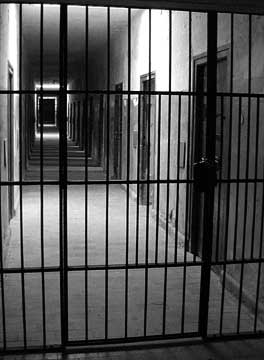 |
|||
|
The photo at right is a view down the perimeter fence - made of barbed wire and electrified. The ditch at left was filled with water to slow escapes and make it easier for the guards to shoot them with their machine guns from the guard towers. Conditionsin the camp were so bad that running and throwing oneself at the fence became a common method of suicide. The living quarters have been demolished, but a replica has been made to show what the living conditions were like. Many of the administrative buildings remain, as well as the prison and crematorium. There is an excellent tour in English daily that takes about 2 1/2 hours, and covers in detail and tone the events that led up to the creation of the camps, the running of the camps, the fate of the people sent there, and the attitudes of the SS running the camps. Our guide also explained some of the reactions of the German people to the atrocities and how the German people have dealt with them over the years. He used his grandparents and parents of examples of the way that the people who were adults and children during the time of the war chose to ignore or suppress the facts and taught their children that it was not a subject to be discussed. It was not until the 70’s that the younger generations started asking questions - now it is no longer taboo. At left is a view down the hall of the prison where prisoners were isolated from the camp population. Isolation for long periods as well as being confined in tiny, small spaces were common torture methods for the prisoners. Those not sent to the prison were often hung from poles by their arms after their arms were tied behind behind their backs - they spent hours or days, depending on the punishment being suspended with their arems dislocated from the shoulder sockets..
The crematorium still exists, as do the ovens used to cremate the people who died (right). Next to the crematorium is the gas room, and although it was never used at Dachau, it was the model for those constructed at other camps. The prisoners that were cremated here died from starvation, overwork, torture, sickness, medical experiments, firing squad or being shot or electrocuted while trying to escape. The memorial pictured below was erected several years ago and captures the sense of the |
|||
|
If you find typographical errors or have any other problems when looking at the site please contact the Webmaster describing the problem and the page involved. |
|||
|
Copyright © 2000-2009 Jim Seavey and Verna Norris All Rights Reserved |
|||
 On our visit to Munich in September, 2002, we took a day trip to Dachau to visit the concentration camp that was built there during World War II. This was the first concentration camp built. Dachau was the prototype for all of the concentration camps. Initially Dachau was used to imprision anyone who dissented with the Nazi’s. Then it was also used to inter anyone that the Nazi’s felt was not acceptable to their way of life, like homosexuals and people of other ethnic origins. The most widely known of these groups are the Jews, but the Jews were not the only minority group that the Nazi’s chose to exterminate.
On our visit to Munich in September, 2002, we took a day trip to Dachau to visit the concentration camp that was built there during World War II. This was the first concentration camp built. Dachau was the prototype for all of the concentration camps. Initially Dachau was used to imprision anyone who dissented with the Nazi’s. Then it was also used to inter anyone that the Nazi’s felt was not acceptable to their way of life, like homosexuals and people of other ethnic origins. The most widely known of these groups are the Jews, but the Jews were not the only minority group that the Nazi’s chose to exterminate.
 There is an extensive museum located in what was the administrative building that covers, in detail, the information given to us by the guide. In the museum they have used many old posters, pictures, and firsthand experiences to highlight the sense of the times leading up to the camps as well as the suffering endured at the camps.
There is an extensive museum located in what was the administrative building that covers, in detail, the information given to us by the guide. In the museum they have used many old posters, pictures, and firsthand experiences to highlight the sense of the times leading up to the camps as well as the suffering endured at the camps. desperate, emaciated people fighting against the barbed wire to be f r e e. T h e 2 c o lumns of trees in the background mark where the rows upon rows of barracks stood. Our hope is that we can move forward from here and never forget nor repeat what happened. And, as is writen elsewhere in the camp, “Never Again”.
desperate, emaciated people fighting against the barbed wire to be f r e e. T h e 2 c o lumns of trees in the background mark where the rows upon rows of barracks stood. Our hope is that we can move forward from here and never forget nor repeat what happened. And, as is writen elsewhere in the camp, “Never Again”.